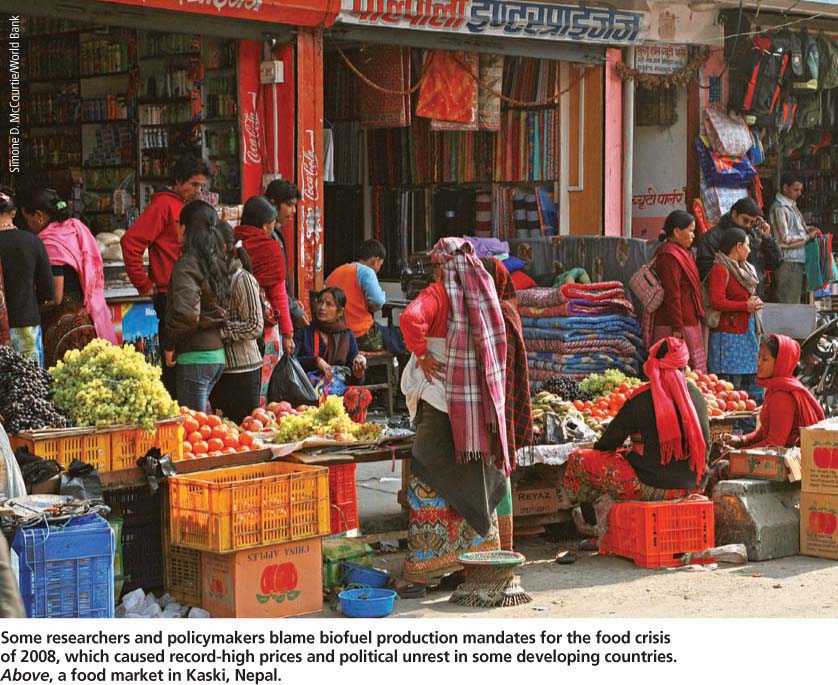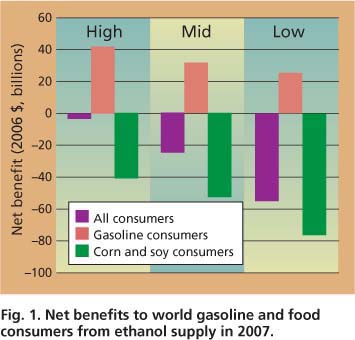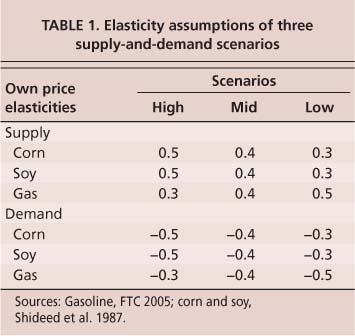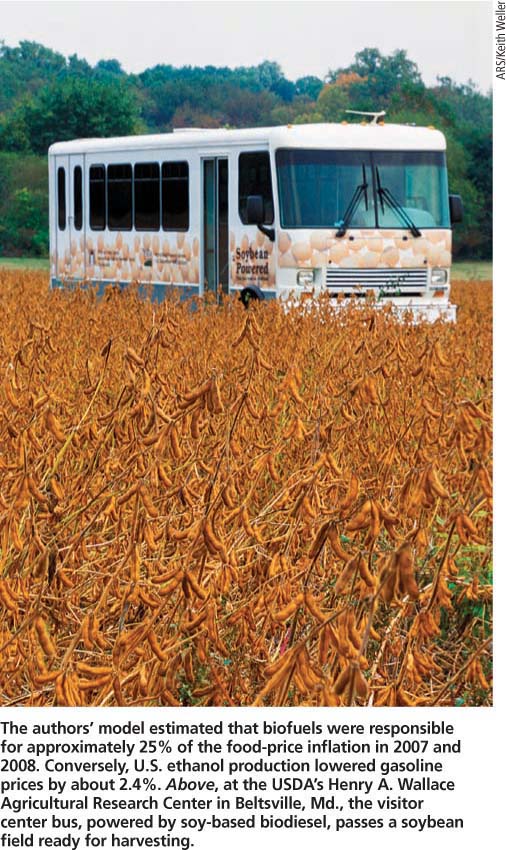All Issues
Model estimates food-versus-biofuel trade-off
Publication Information
California Agriculture 63(4):199-201. https://doi.org/10.3733/ca.v063n04p199
Published October 01, 2009
PDF | Citation | Permissions
Abstract
Biofuels have been criticized for raising food prices and reducing food production. While biofuels have rightly been blamed for contributing to reduced food security at a time of record-high food prices in 2008, they have not been credited with reducing the cost of gasoline, also at a time of record-high prices. We discuss the food-versus-biofuel trade-off associated with biofuel production and model the effects of biofuel production in markets for key crops and gasoline, showing that food consumers lose from biofuels but gasoline consumers enjoy substantial benefits. We also suggest ways to address the food-versus-biofuel debate.
Full text
Some researchers and policymakers blame biofuel production mandates for the food crisis of 2008, which caused record-high prices and political unrest in some developing countries. Above, a food market in Kaski, Nepal.
IN 2008, the world entered a food crisis amid record-high commodity and energy prices that induced hunger and political unrest in developing countries, thefts of food from farms and food-aid caravans, and export restrictions in top grain-producing countries. The food crisis struck as biofuel production, driven largely by state mandates and subsidies, reached its pinnacle. The link between first-generation biofuels and food, which compete for land and harvest, was clear to researchers and policymakers, who blamed biofuel production mandates in developed countries for the 2008 food crisis (Traynor 2008).
The degree to which biofuels contributed to high food prices is likely overstated in the popular press, but even researchers don't agree on how much blame rests with biofuels. At the same time that food prices climbed, energy prices, particularly for oil, rose considerably, increasing the costs of transportation and further constraining household budgets. Amid the firestorm over the role of biofuels in the food crisis, their role in reducing transportation energy costs has largely been overlooked. It is, nevertheless, substantial.
We present a model that quantifies the effects of biofuel production on food and gasoline consumers in the United States and the rest of the world, and show that gasoline consumers benefit significantly from reduced prices whereas corn and soy consumers lose from higher prices.
Multimarket framework model
The introduction of biofuels affected both food and fuel markets. Biofuels utilize resources used to grow food crops and thus reduce food supplies. Hence, the introduction of biofuels increases the price of staple crops, especially corn and soybeans consumed by livestock, people and biofuel producers. At the same time, biofuels increase fuel supplies, reducing fuel prices and increasing fuel consumption.
While theory can predict the qualitative effects of biofuels on food and fuel, quantitative measures are also required to derive policy recommendations. We build on a partial-equilibrium multimarket framework to model the interactions between supply and demand in several markets. This structure estimates the impact of biofuels, particulary on prices and quantities in food and fuel markets, and on buyers and sellers in these markets.
Key parameters in these analyses are the price elasticities of supply and demand — the responsiveness of quantities supplied or demanded to a given change in prices. Both food and fuel markets are characterized by low demand elasticities. Therefore, even a small increase in the supply of food or fuel induces a large drop in the price of food or fuel, respectively. For example, if biofuels increase the availability of fuel by 1% and prices go down by 2%, then the demand elasticity is −0.5 (−0.5 = 1%/−2%).
We extended the model described in Rajagopal et al. (2007) to estimate the potential effects of U.S. biofuel production on welfare and simulate a global multimarket equilibrium comprising markets for corn, soybeans, ethanol and gasoline. We considered two regions: the United States and the rest of the world. We assumed that the “own” price elasticities (responsiveness of demand and supply of a crop to change in its price) and the cross-price elasticities (responsiveness of supply and demand for a crop to changes in the relative prices of other crops) did not vary across regions. The equilibrium prices and quantities were then computed assuming two scenarios: no biofuel production and biofuel production at 2007 levels.
The simulation results are reported for three distinct sets of assumptions about price elasticities for food and gasoline: (1) a “high” scenario characterized by highly elastic crop markets and an inelastic gasoline market, (2) a “low” scenario that assumes the opposite, a low elasticity for food and an elastic gasoline market and (3) a “mid” scenario that assumes moderately elastic markets for both food and gasoline (table 1). Biofuel production has the greatest benefit to consumers in the high scenario.
Research suggests that gasoline elasticities tend to be less than 0.3 in the short run. Similarly, for corn and soy, short-run elasticities tend to be less than 0.3. If so, our high scenario provides a conservative estimate of the net consumer benefits from biofuel production. Even long-run gasoline elasticities are less than 0.5.
To reduce the complexity of simulations and for ease of exposition, we assumed fixed cross-price elasticities between corn and soy across all scenarios. The cross-price supply elasticities of corn with respect to soy, and vice versa, are −0.076 and −0.13, and the demand elasticities are 0.123 and 0.027, respectively (Shideed 1987).
In our analysis, we included the impact of biodiesel on the soy market, but did not estimate its impact on the diesel market, which makes our assessment of fuel-market benefits even more conservative. Including the diesel-market equilibrium would increase gasoline (or “transportation fuel”) consumer benefits.
Impacts on food and gas prices
Without ethanol supplies, gasoline prices would be between 2.4% (high scenario) and 1.4% (low scenario) higher (table 1). By increasing petroleum supplies, ethanol production reduces prices for fossil fuels, benefiting consumers of transportation fuels. Biofuel production, however, raises the price of food commodities by reducing the supply of crops for food processing. In our model, biofuel production caused the price of soy to increase 10% to 20% and the price of corn to increase 15% to 28% in 2007. In contrast, much lower biofuel production in 2006 caused the price of soy to increase between only 2% and 7% and the price of corn to increase between only 5% and 13%, according to the model. Though not expressly modeled in this analysis, the effects on soy and corn consumers can be expected to carry over to other agricultural commodities, particularly coarse grain (Zilberman 2008).
The authors' model estimated that biofuels were responsible for approximately 25% of the food-price inflation in 2007 and 2008. Conversely, U.S. ethanol production lowered gasoline prices by about 2.4%. Above, at the USDA's Henry A. wallace Agricultural Research Center in Beltsville, Md., the visitor center bus, powered by soy-based biodiesel, passes a soybean field ready for harvesting.
Given our simulated price effects, we estimated the welfare effects of ethanol production. In figure 1, we present the benefits to world gasoline and food consumers under each of the three scenarios considered in our analysis. In the mid scenario, we find that gasoline consumers worldwide benefited from 2007 U.S. biofuel production by about $31.3 billion because of 1.8% lower gas prices. The total cost to food consumers and U.S. taxpayers (in the form of subsidy payments), however, was $52.8 billion. The net gain to corn and soybean producers was about $27 billion. Under plausible conditions and partial-equilibrium analysis, ethanol production was associated with a net benefit worldwide of $1.7 billion. Overall, the rest of the world gained $4.7 billion, whereas the United States lost $3 billion (net of taxes).
In the United States, under the mid scenario, gasoline consumers gained approximately $7.2 billion, whereas the total cost to corn and soy consumers was $17.4 billion, and the cost to taxpayers from the U.S. Volumetric Excise Tax Credit was $2.2 billion. Higher food prices benefited U.S. corn and soy producers by $11 billion (producers in the rest of the world gained $27 billion).
Some have argued that the cost of ethanol subsidies should not be counted against biofuel production in welfare analysis because it displaces traditional farm-policy payments. Our simulations, however, revealed that corn prices would likely have remained above specified loan rates for 2007 without ethanol-induced price increases. The cost of ethanol subsidies, therefore, is not likely to have been offset by reduced subsidies to corn.
This analysis ignores the loss to oil producers worldwide from lower oil prices. Considering rhetoric from political leaders in oil-importing countries, these losses may not be of great concern from a policy standpoint. It should be emphasized that the foregoing analysis is partial. It does not consider the impacts of biofuels on other markets that are directly affected, such as sugar, or indirectly affected, such as wheat. We ignored potential market distortions apart from the ethanol production subsidy. We have not estimated the consumer benefits resulting from changes in carbon emissions and other pollutants due to ethanol or the welfare effects of tariffs on ethanol imports.
Despite these limitations, this analysis is useful to determine the orders of magnitude of biofuel price effects. It suggests that U.S. ethanol production alone reduced gasoline prices as much as 2.4% in 2007. To the extent that biofuels do reduce oil imports and prices, they can also be a mechanism for improving countries' terms of trade (i.e., net exports).
Food-versus-biofuel debate
Several reports have examined the factors responsible for the global food-price inflation in 2008 (Abbott et al. 2009; IFPRI 2008; IRRI 2008; Mitchell 2008). While there is generally consensus among researchers that forces such as economic growth, rising energy prices, adverse weather, devaluation of the U.S. dollar and biofuel policies contributed to the 2008 food crisis, the magnitude of these effects is a source of debate. Whereas U.S. Department of Agriculture chief economist Joe Glauber estimates the biofuel impact on a global food index to be 10% (USDA 2008), Mitchell (2008) puts it at around 75%. The various attempts to quantify these effects are based on different assumptions, data and study periods, which explains the variations and complicates the development of consensus among academics (FAO 2008).
In contrast to existing literature, we used a multimarket approach to characterize the impact of biofuels on two prominent food markets, corn and soy. Biofuels indirectly affect other food markets by raising demand for farm inputs, including land, labor and chemicals. But for corn and soy, biofuel production competes for harvest, diverting production from its other predominant uses in food and feed. We show that, on average, the introduction of biofuels was responsible for one-quarter of food-price inflation in 2007 and 2008.
In future research, we plan to extend this methodology and include crop inventories in addition to policies such as biofuel subsidies and mandates. Whereas biofuel subsidies and mandates increase the current demand for staple crops, low inventories reduce future demand. Both effects reduce food availability and increase food prices. We also plan to introduce noncompetitive behavior to the energy market, in contrast to the competitive behavior assumed in the existing literature.








